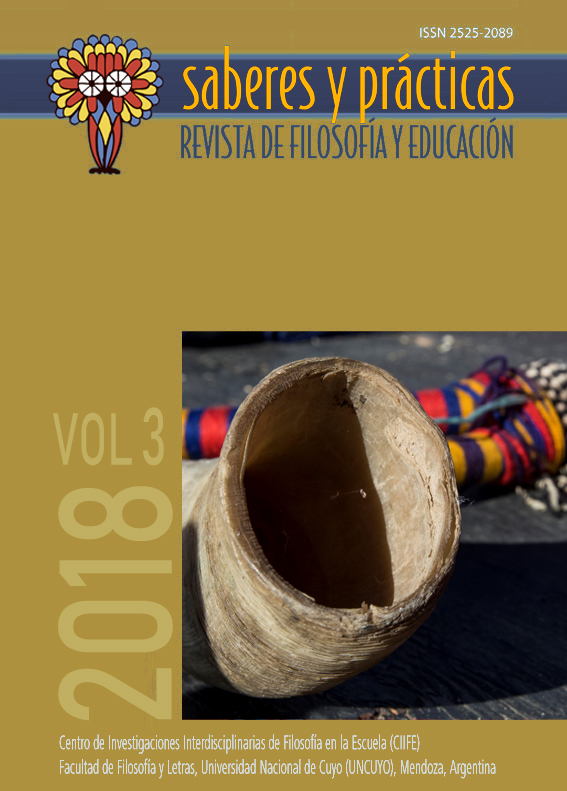Emberas: problema y posibilidad. Un Análisis sobre las prácticas didácticas indígenas en el contexto intercultural colombiano
Palabras clave:
Práctica didáctica, Educación propia, Formación docente, Enseñanza de la lenguaResumen
Este artículo nace de la investigación Las prácticas pedagógicas de docentes indígenas en el área del lenguaje en su relación con el fortalecimiento cultural y comunitario del pueblo embera eyábida del Occidente de Antioquia, el cual apuntó hacia las prácticas didácticas para la enseñanza de los saberes culturales propios y modernos del pueblo embera, el uso y enseñanza de la lengua nativa y la lengua castellana y las metodologías implementadas para alcanzar tales aprendizajes en instituciones educativas de contexto indígena. La complejidad y posibilidad de la práctica didáctica en este contexto indígena radica en cohesionar los saberes kapunia u occidentales con los propósitos de la "educación propia". Es así como nos interesamos por conocer las prácticas didácticas de aula a propósito de la enseñanza de la lengua nativa y del español, y observamos múltiples limitantes heredados de enfoques pedagógicos y modalidades didácticas aprendidas tanto en la etapa en que los ahora maestros eran aprendices de la lengua castellana en la escuela tradicional rural como en su etapa de formación como docentes normalistas y licenciados.
Descargas
Citas
Aguirre, Daniel, Rubén Gonzalez y Macario Panchí. 2013. Karta ẽbẽra bedea bɯ kawabiy ita – Manual de enseñanza y escritura ẽbẽra-chamí. Gerencia Indígena Gobernación de Antioquia Medellín: Imprenta Departamental de Antioquia.
Bodnar, Yolanda C. 2006. "Una mirada a la etnoeducación desde las prácticas pedagógicas culturales". En: Interacciones Multiculturales, Los Estudiantes Indígenas En La Universidad. Bogotá: Corporación para la Producción y Divulgación de la Ciencia y la Cultura – CORPODRIC.
Bodnar, Yolanda C. 1992. La Constitución y la etnoeducación: ¿una paradoja? Educación y Cultura 27: 20-23.
Calvo Población. Gaspar Félix y García Bravo, William. 2013. Revisión Crítica de la Etnoeducación en Colombia. Historia de la Educación, Vol. 32. Ediciones Universidad de Salamanca, pp.343-360. http://campus.usal.es/~revistas_trabajo/index.php/0212-0267/article/view/11296/11714
Carrioni, Gina D. 1992. Formación de indígenas en etnoeducación. Educación y Cultura 27: 24-27.
Castillo Guzmán, Elizabeth. 2008. Etnoeducación y políticas educativas en Colombia: la fragmentación de los derechos. Revista Educación y Pedagogía. Medellín, Universidad de Antioquia, Facultad de Educación. Vol. XX, Nº 52. http://aprendeenlinea.udea.edu.co/revistas/index.php/revistaeyp/article/view/9879/9076
Enciso Patiño, Patricia. 2004. Estado del arte de la etnoeducación en Colombia con énfasis en política pública, Ministerio de Educación Nacional, Dirección de Poblaciones y Proyectos Intersectoriales Subdirección de Poblaciones.
García Rodríguez, María Luisa y García Díaz, Noemí. 2017. Cincuenta palabras generatrices para el aprendizaje del código escrito de la lengua española -Adaptación del método de Paulo Freire a la edad infantil. En Didáctica- Lengua y Literatura. Madrid, Nº 29: 81-102.
Ministerio de Educación Nacional. Decreto 804 de 1995.
Ministerio de Educación Nacional. Ley 115 de 1993.
Ministerio de Educación Nacional. Ley 1381 de 2010.
Ministerio de Educación Nacional. Decreto 1953 del 07-10-2014 o SEIP (Sistema de Educación Indígena Propio).
Mendoza Castro, Clemente. 2001. Pedagogía indígena: una visión diferente de hacer educación en Colombia. Nodos y nudos: revista de la Red de Calificación de educadores. Vol. 2, Nº. 10. 42-50.
Plan De Salvaguarda Emberá. Capítulo Antioquia. 2011. Organización Indígena de Antioquia – Ministerio del Interior y de Gobierno.
Patino Londoño, Gustavo. 1996. Etnoeducación una alternativa cultural transformadora. Revista de Ciencias Humanas, 10: 75-82.
Trivino Garzón. Lilia. 2006. Logros y retos de la etnoeducación en Colombia, Universitas, Revista de Ciencias Sociales y Humanas, 7: 145-181.
Descargas
Archivos adicionales
Publicado
Cómo citar
Número
Sección
Licencia

Esta obra está bajo una Licencia Creative Commons Atribución-NoComercial-CompartirIgual 2.5 Argentina.
Los/as autores/as que publican en esta revista están de acuerdo con los siguientes términos:
1. Los/as autores conservan los derechos de autor y garantizan a la revista el derecho de ser la primera publicaci´´ón del trabajo bajo una licecncia Creative Commons Atribución-NoComercial-CompartirIgual 2.5 Argentina . Por esto pueden compartir el trabajo con la referencia explícita de la publicación original en esta revista.
2. Saberes y prácticas permite y anima a los autores a difundir la publicación realizada electrónicamente, a través de su enlace y/o de la versión postprint del archivo descargado de forma independiente.


































